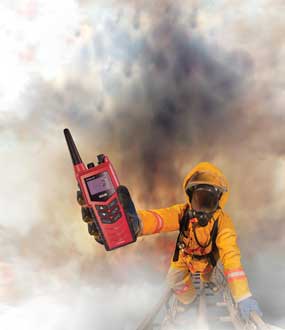 Cobham SATCOM’s well established line of SAILOR portable radios has been extended with the SAILOR 3965 UHF Fire Fighter; the world’s first marine approved portable radio made specifically for fulfilling the new SOLAS Chapter II-2, Regulation 10.10.4 – ‘Fire Fighters Communication’.
Cobham SATCOM’s well established line of SAILOR portable radios has been extended with the SAILOR 3965 UHF Fire Fighter; the world’s first marine approved portable radio made specifically for fulfilling the new SOLAS Chapter II-2, Regulation 10.10.4 – ‘Fire Fighters Communication’.
The SAILOR 3965 UHF Fire Fighter portable radio meets standards set out that require approx. 65,000 (existing) SOLAS vessels worldwide to provide intrinsically safe portable radios within the regulated ‘fire fighter outfits’ on board, prior to a vessel’s first survey after July 2018. Cobham SATCOM defines that in order to conform to requirements, fire fighter radios must be: Explosion-proof or intrinsically safe; ready for use at all times; capable of use by fire fighters (considering i.e. gloves, suits, poor visibility); made for the marine environment and carried in addition to existing on board portable work radios.
SOLAS Chapter II-2, Regulation 10 contains requirements for the fire fighter outfits (of which portable radios are considered a part), and how many outfits are required for a specific vessel. As a rule of thumb, any vessel covered by SOLAS must carry at least two fire fighter outfits, and for passenger ships the number of fire fighter outfits is increased and regulated both by i.e. the number of passengers and vertical fire zones.
The SAILOR 3965 UHF Fire Fighter portable radio helps owners meet the 2012 amendment 10.10.4.: For ships constructed on or after 1 July 2014, a minimum of two two-way portable radiotelephone apparatus for each fire party for fire-fighter´s communication shall be carried on board. Those two two-way radiotelephone apparatus shall be of an explosion-proof type or intrinsically safe. Ships constructed before 1 July 2014 shall comply with the requirements of this paragraph not later than the first survey after 1 July 2018.
As a leading authority on SOLAS regulations in a communications context, Cobham SATCOM’s design engineers have studied closely the new requirements in order to develop a radio solution that is not only a cost-effective response for shipowners to the logistical challenges of equipping their vessels in the coming years, but a highly reliable and effective communication tool that can be counted on by fire fighters in extreme, hazardous environments on board.
The SAILOR 3965 UHF Fire Fighter portable radio is based on Cobham SATCOM’s series of SAILOR portable work, GMDSS and ATEX radios but has been designed specifically to keep fire fighters safe through reliable, function rich communication. The most striking aspect of the new radio is its bright red colour, which signals to crew members on board that the radio should not be used for daily operations and must stay as part of the fire fighter outfit.
The radio features an easy to read display for channel and battery information, and is compatible with a wide range of established 3rd party accessories from SAVOX and Peltor. Considering the potential for low or zero visibility due to smoke during a fire, the SAILOR 3965 UHF Fire Fighter portable radio features large, tactile buttons, and audio confirmations of i.e. channel changes in the operator’s headset.
Uniquely, the SAILOR 3965 UHF Fire Fighter portable radio is the only maritime radio system to accommodate spare emergency battery packs. As standard, it features an ATEX 1.800 mAh rechargeable Li-Ion Battery, IP67 battery pack, however, Cobham SATCOM also offers ATEX approved non-rechargeable emergency batteries, providing an extra level of security to ensure communication is available when a fire breaks out, or rechargeable batteries run-down.
Operationally, the SAILOR 3965 UHF Fire Fighter portable radio offers a long feature list that supports safe fire fighting process and ensures that it meets the standards set out in Regulation 10.10.4., such as: Tone Coded Squelch System (CTCSS) to avoid interference from other nearby vessels and Trunked Mode Operation (TMO) for vessels with a repeater system.
“We estimate that some 300,000 new radios will be required for the remaining SOLAS vessels to fully conform to the new regulations that effectively come into force in a little over two years’ time,” said Claus Hornbech, Business Manager – Maritime Integration, Cobham SATCOM. “Because of the timescale, we have developed several packages based on the SAILOR 3965 UHF Fire Fighter portable radio that make it easy for owners of different vessel types to meet the regs, with the confidence that crews will have immediate access to radios designed only for the job of fighting fires.”


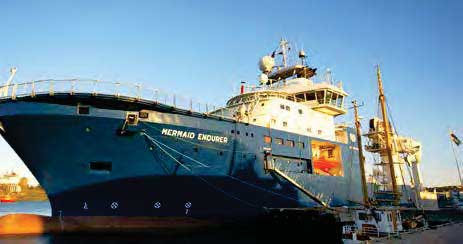 Mermaid Maritime Public Company Limited
Mermaid Maritime Public Company Limited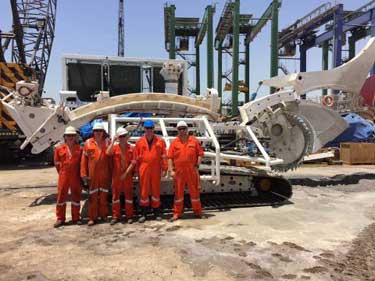 Photo credit: Deep Ocean
Photo credit: Deep Ocean 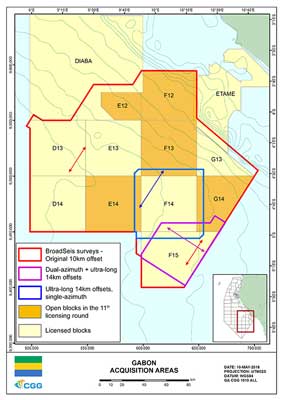 Map showing available license blocks and coverage of new broadband 25,000-km2 multi-client survey and additional data being acquired in blocks F14 and F15. Credit: CGG
Map showing available license blocks and coverage of new broadband 25,000-km2 multi-client survey and additional data being acquired in blocks F14 and F15. Credit: CGG  Autonomous underwater vehicles (AUVs) have been in operation for a number of years and are an established part of underwater activity, particularly in research and military where they are utilized for activities such as mine clearance, hydrography and data collection. Despite widespread use, there is still potential for substantial growth – each new technological advance increases the viability of the vessels in different sectors. This is particularly clear in oil & gas, where AUVs remain niche assets.
Autonomous underwater vehicles (AUVs) have been in operation for a number of years and are an established part of underwater activity, particularly in research and military where they are utilized for activities such as mine clearance, hydrography and data collection. Despite widespread use, there is still potential for substantial growth – each new technological advance increases the viability of the vessels in different sectors. This is particularly clear in oil & gas, where AUVs remain niche assets.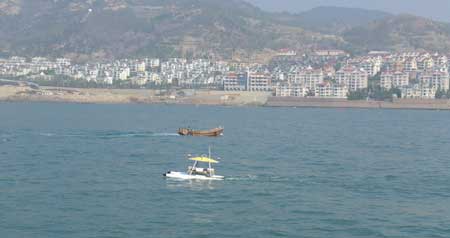 SeaRobotics Corporation
SeaRobotics Corporation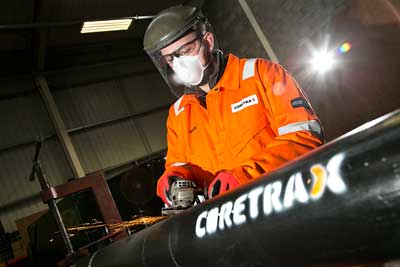
 Cobham SATCOM’s
Cobham SATCOM’s Chet Morrison Contractors
Chet Morrison Contractors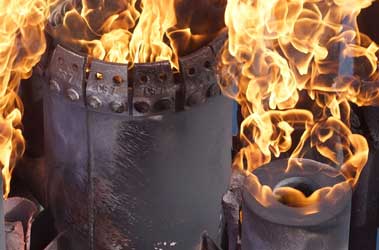 Drones are able to capture close up images of many onshore and offshore assets, including flares. Credit: Cyberhawk Innovations
Drones are able to capture close up images of many onshore and offshore assets, including flares. Credit: Cyberhawk Innovations 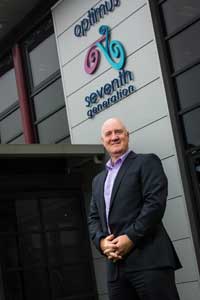 Derek Smith, chief executive at Optimus Seventh Generation
Derek Smith, chief executive at Optimus Seventh Generation 
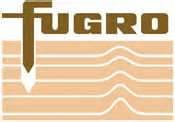 The
The 
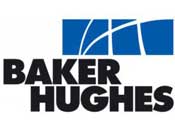 Baker Hughes Incorporated
Baker Hughes Incorporated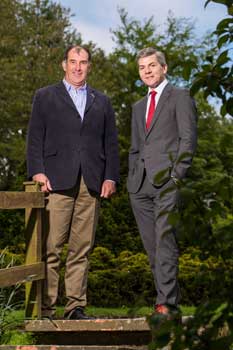
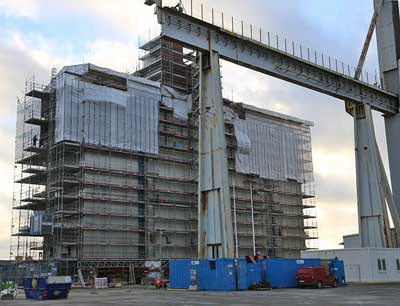 In the Arendal Yard in Gothenburg, Sweden, Apply Emtunga is building the offshore accommodation modules to the oil rig projects Martin Linge and ETAP. As the living quarters are to be the safest place on a rig Apply Emtunga puts a lot of effort into creating maximum safety. One way to ensure safety is to use Roxtec cable and pipe transits.
In the Arendal Yard in Gothenburg, Sweden, Apply Emtunga is building the offshore accommodation modules to the oil rig projects Martin Linge and ETAP. As the living quarters are to be the safest place on a rig Apply Emtunga puts a lot of effort into creating maximum safety. One way to ensure safety is to use Roxtec cable and pipe transits.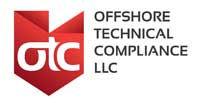 Offshore Technical Compliance (OTC)
Offshore Technical Compliance (OTC)